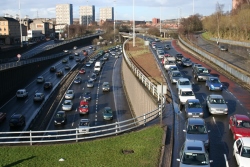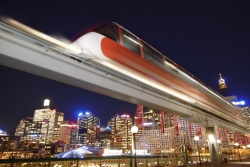
Unprecedented growth of cities has already provoked enormous challenges. Statistics currently show 80 per cent of the European Union citizens living in urban areas with 40 per cent living in large cities of over 200,000 residents. The growth of these cities, has led to a growth in demand for both freight and personal mobility within urban areas. Ownership and use of private vehicles in cities of all economies are rapidly increasing. As a result, busy urban roads are partly responsible for a number of externalities such as most congestion problems being centred on cities; one in three road fatalities taking place in cities; 3.7 million people killed annually by outdoor air pollution.
The common challenge for all major cities is how to reconcile demand for freight and passenger mobility, while reducing congestion, traffic accidents and environmental impact. This was at the centre of the debates of the policy segment opening the 77th session of the Inland Transport Committee (ITC) “Rethinking sustainable urban transport and mobility to meet the challenges of a new era”, which gathered high level government and transport sector representatives from across the globe.
The policy debate considered how cities develop sustainable urban transport models which allow for safe, environmentally friendly and affordable transportation, what good practices the UNECE cities offer and which are the main issues for future analytical, advisory and regulatory activities.
On this occasion UNECE launched its report on “Sustainable Urban Mobility and Public Transport in UNECE Capitals” . The analysis, which draws on data from 34 capital cities, highlights some of the shortcomings in accessibility, speed, age of vehicle fleet, affordability of ticket price etc. On the other hand, the report demonstrates that most of the capital cities in the UNECE region offer an overall good quality of public transport.

“Comparing the technological features of public transport in the nineties to what we have today (e.g. in traffic management or passenger information) – and before even considering what new technology is around the corner such as autonomous vehicles - we could safely say that we are in the middle of a new technological revolution for urban public transport,” said Eva Molnar, director of the Transport Division. “However, we are lagging very much behind in policy considerations and particularly in planning for the paradigm shift for efficient, sustainable and convenient urban mobility at an affordable cost. This policy debate is therefore meant to contribute to filling the knowledge-gap and facilitate the acceptance of a new era for urban mobility.”
The varieties of the presentations from policy makers to academics, coming from the Netherlands, Hungary, Russian Federation, Croatia, and Switzerland among others, showed that developing sustainable urban transport systems is an achievable goal despite the huge challenges.
Mr Nicolas Meilhan, Principal Consultant Energy & Transportation Practices, Frost & Sullivan, France said that while embracing electric cars would cut down on carbon emissions, this would not address the problem of limited space for individual ownership, congestion and parking. Advancing technologies have enabled greater and complementary alternatives to develop for the transport of people but also of goods in urban environments. We should also look to embrace the alternatives that currently exist such as vehicle sharing - car, scooter & bike – or ride sharing which are becoming more convenient through new technology and social media.
Mr Nikolay Asaul, Deputy Minister of Transport of the Russian Federation, spoke of the steps taken to address the transport needs of a rapidly urbanizing Russian Federation. “In 2011 we created two special directorates, the Directorate of the Moscow Transport Hub and Directorate of the Saint Petersburg Transport Hub. This allows for interregional and local transport issues to be addressed at both a federal and local level where each individual system compliments the whole.”
The establishment of the Directorate of the Moscow Transport Hub has allowed for the upgrading of the Moscow public transport programme in a coordinated method which what that still compliments the national transport system. The main implementation tool is the Program of the Moscow Transport Hub Development till 2020 which provides for a whole assortment of measures ranging from extending the subway and railway lines to Moscow suburbs, constructing new infrastructure, better traffic management and use of urban spatial planning as well as better control over air pollutants and promoting law-carbon vehicles, e-mobility, cycling and foot-walks.

Blaise Hochstrasser, Directeur général à la Direction Générale des Transports de l'Etat de Genève), Switzerland spoke about the impressive development of the greater Geneva area. In cities like Geneva space is a very limited commodity, so for public transport to be effective a principle of multi-modality must be followed. “Each day, depending on where you are going and what you are carrying with you, your mode of travel may change,” said Mr Hochstrasser. “Therefore we must develop smarter urban transport, taking into account limited space, where one can seamlessly cross several transport modes to reach one’s destination.”
In addition to the cities transport system working seamlessly together, is the need for the system to reach outside the city. In Geneva’s case many of those working in Switzerland live in France or in another Swiss Canton. Mr Hochstrasser explained, “We have 275,000 people crossing the cantons border every day twice. 33 per cent are coming by train from Lausanne in the canton of Vaud, while only 2 per cent are coming from Evian, France by bus, and the rest come by car.” To increase mobility options or those crossing borders a new rail project is underway named, CEVA. This project not only better connects Geneva with Lausanne, in an example of efficient international cooperation, it will also allow easier and more comfortable travel from France, providing another option for commuting aside from bus or car.
Mr. Vojkio Obersnel, the Mayor of Rijeka in Croatia discussed the steps taken in his historic port city to improve the road and railway connections to the hinterlands of Croatia and the rest of Central Europe without jeopardizing local mobility in the Rijeka city and how a well-designed transport development plan helped economic revitalisation. “We hope that a modernization of the Rijeka railway and the linking to the hinterland will lead the same development that occurred when railways first came to the port of Rijeka 150 years ago. “
Note to editors
The policy debate marked the beginning of the 77th session of the Inland Transport Committee (ITC) of the United Nations Economic Commission for Europe (UNECE). The Inland Transport Committee is the only permanent body in the United Nations specialised in the development of inland modes of transport in a safe, efficient and environmentally friendly way. The ITC is serviced by the UNECE Sustainable Transport division.
The 77th ITC will focus on developing efficient, safe and secure pan-European and Euro-Asian transport links, sustainable road, rail, inland water transport, intermodal transport and logistics, climate change and transport, border crossing facilitation, road safety, harmonization of vehicle regulations, transport of dangerous goods as well as assistance to countries with economies in transition.
These discussions are happening at the same time as the ongoing negotiations on the framework of the Post-2015 Sustainable Development Agenda which will include concrete goals with measurable and achievable targets. This agenda is expected to greatly impact the development path of the world, as well as the future work of the United Nations. The ITC, as the unique intergovernmental body specializing in inland transport, is contributing to the global debate to help build consensus on the important role of the transportation sector in sustainable development and the post-2015 Sustainable Development Framework.